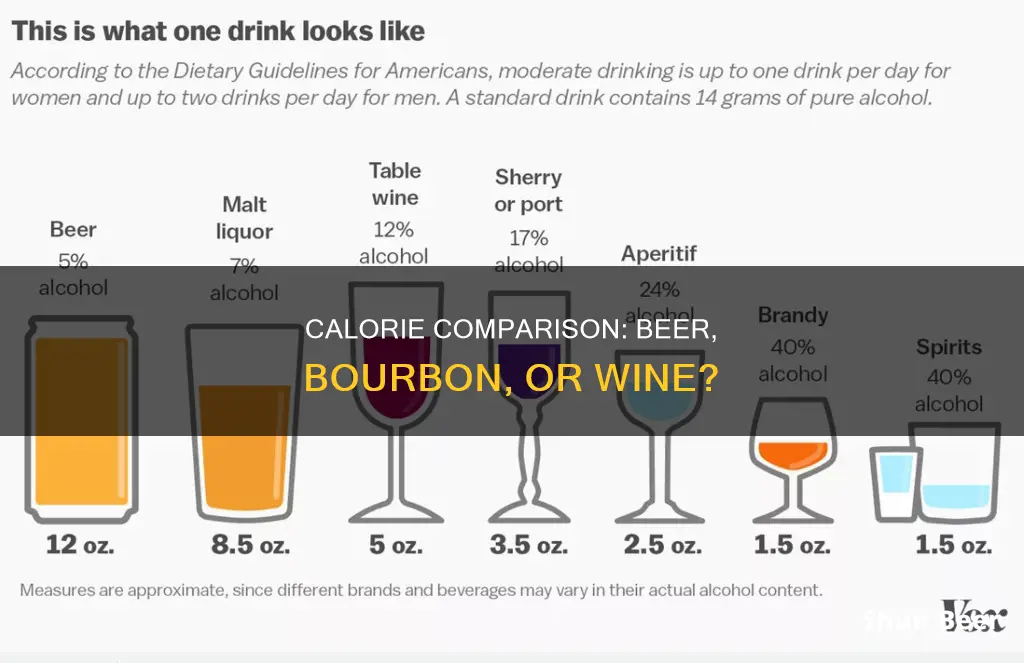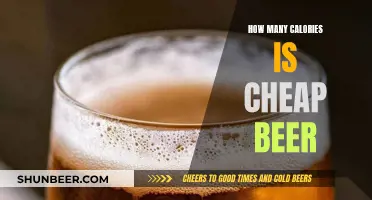
Alcoholic drinks can be deceiving when it comes to calories. They can quickly add 500 calories or more to your daily intake, and most alcoholic drinks have little to no nutritional value. So, which has the most calories: beer, bourbon, or wine? All three drinks have different calorie counts, depending on their alcohol content, volume, carbohydrates, sugars, and mixers.
Characteristics of Beer, Bourbon and Wine
| Characteristics | Values |
|---|---|
| Beer calories | Depend mostly on alcohol content and, to a lesser extent, on carbs. A typical 12 oz beer has 140 calories. Very-low-alcohol beers (2% to 3% alcohol) start at around 60 calories in 12 oz. Most lights (4% alcohol) have about 100 calories. An average 5% alcohol beer has around 150 calories. Heavy hitters (7% to 11% alcohol) pack 200 to 300 calories. |
| Bourbon/Whiskey calories | A shot of bourbon/whiskey has 100-120 calories. "Cask strength" or "barrel proof" or "overproof" liquor can reach 150 calories. |
| Wine calories | Red or white wine has roughly 150 calories for 6 ounces. A 9 oz. glass reaches 220 calories. Lighter wines have around 70 to 80 calories per 5-oz. glass. A glass of sangria typically has 200 to 300 calories. |
What You'll Learn

Beer calories depend on alcohol content and carbs
When it comes to alcoholic drinks, beer, wine, and bourbon all have varying calorie counts, depending on their alcohol content and other ingredients. Beer calories, in particular, depend mostly on alcohol content and, to a lesser extent, on carbohydrates (or carbs).
A typical 12 oz beer, such as Budweiser, has about 140-150 calories, which is similar to a can of Coke. However, the calorie count can vary significantly depending on the type of beer and its alcohol content. Very-low-alcohol beers, like Miller 64 (2-3% alcohol), start at around 60 calories for a 12 oz serving. On the other hand, light beers, which usually have 4% alcohol, contain about 100 calories.
The calorie count increases with higher alcohol content. Regular beers, with an average alcohol content of 5%, typically have around 150 calories. For example, Budweiser, a classic American lager, falls into this category.
If you're looking at heavier beers, such as IPAs, double IPAs, or Belgian-style Trippels, the calorie count can go up to 200-300 calories per serving due to their higher alcohol content (7-11%). However, there are also lower-alcohol "session" IPAs that bring the calorie count down to around 140. Additionally, some newer "lo-cal" IPAs, like Dogfish Head Slightly Mighty, can have as few as 100 calories.
When ordering draft pours, keep in mind that a larger serving size of 16 or 20 oz can increase the calorie count to 200 or even 250 calories. So, if you're watching your calorie intake, it's important to be mindful of both the type of beer and the serving size.
In summary, beer calories depend on both alcohol content and, to a lesser extent, carbohydrate content. The higher the alcohol content, the higher the calorie count tends to be. So, when making choices about your beverage, considering the alcohol content can help you understand and manage your calorie intake.
Mickey's Beer: Calorie Count and Nutrition Facts
You may want to see also

Wine has fewer calories than beer
It's true: wine has fewer calories than beer. But that doesn't necessarily make it a healthier option. Alcoholic drinks, in general, have little to no nutritional value. And, of course, the number of calories in a drink will vary depending on its size and alcohol content.
Calories in wine
The number of calories in a glass of wine depends on its type and colour. Rose wine has around 70 to 80 calories per 100ml, white wine has 73 to 83 calories per 100ml, and red wine tends to contain between 75 to 85 calories per 100ml. A standard 175ml glass of 12% ABV wine contains around 133 calories, which is equivalent to eating three Jaffa Cake biscuits. A glass of dry wine (approximately 120 to 125 calories per 5 ounces) is a lower-calorie option.
Calories in beer
The number of calories in a beer depends on its type and colour. Lighter colour beers tend to contain fewer calories than their darker counterparts. This is because lighter beers have a lower alcohol content and lower ingredient density. Most light beers tend to have between 60 and 120 calories, while dark beers have between 100 and 300 calories. A typical 12 oz beer has as many calories as a can of Coke (140). Some have twice that amount. An average 5% alcohol brew like Budweiser hovers around 150 calories.
The calorie difference between wine and beer comes from the leftover carbohydrates in beer, as the sugar content for most wines is fairly low. Beer is made from grain, which stores carbohydrates in the form of starch. Although wine also contains carbohydrates in the form of small amounts of sugar, this amount is generally small and does not contribute significantly to the calorie count.
Australian Beer: Low-Calorie Options for the Health-Conscious
You may want to see also

Spirits have fewer calories than beer
When it comes to alcoholic beverages, it's important to consider not only the type of drink but also its calorie content. Spirits, such as vodka, gin, rum, tequila, and whiskey, generally contain fewer calories than beer. This is because spirits are typically consumed in smaller quantities, and a standard shot of liquor contains 100 to 120 calories, depending on its proof. In contrast, a 12-ounce serving of 5% ABV beer usually has around 150 calories.
The difference in calorie content between spirits and beer becomes more apparent when comparing their nutritional values. Beer tends to have more leftover carbohydrates, while spirits, being distilled, have little to no residual sugar. As a result, a shot of liquor will generally have fewer calories and carbohydrates than a 12-ounce beer.
The production methods of these alcoholic beverages also play a role in their calorie content. Beer, for example, comes in various types, including non-alcoholic, light, and low-calorie options. The lower the calories in a beer, the lower its alcohol content tends to be. On the other hand, spirits like whiskey do not typically come in low-calorie versions, and a lower alcohol content in whiskey often indicates the presence of added ingredients and sugars, increasing the calorie count.
It's worth noting that while spirits have fewer calories per serving than beer, the addition of mixers can quickly increase the calorie count. A mixed drink with rum and Coke, for instance, would have a similar calorie count to a 12-ounce beer. Therefore, when comparing spirits and beer, it's essential to consider not only the base beverage but also any additional ingredients or mixers that may be used.
When it comes to weight management and overall health, it's important to consider not only the number of calories but also the quality of your diet. Alcoholic beverages, regardless of type, have minimal nutritional value and can contribute to weight gain. According to the Dietary Guidelines for Americans, excessive drinking is defined as four or more drinks per day for women and five or more drinks per day for men. Therefore, it's crucial to consume alcohol in moderation or not at all.
Calories in Leinenkugel's Grapefruit Beer: A Healthy Choice?
You may want to see also

Cocktails with mixers are high-calorie
Other mixers to be cautious of include tonic water, juice, soda, syrups, cream and coconut, which all pack sugar and fat calories on top of the alcohol content. Even a can of Coke has 140 calories, the same as a typical 12-ounce beer. So, when you mix a high-calorie mixer with a shot of liquor, you're consuming a significant number of calories in one drink.
Cocktails with multiple shots of liquor and high-calorie mixers can be especially deceiving, as you may not realise how many calories you're consuming in one drink. For example, a Long Island Iced Tea, which typically contains multiple shots of liquor and a sugary mixer, can have upwards of 700 calories. That's almost half the daily recommended calorie intake for an adult woman!
If you're watching your weight, it's best to stick to drinks with lower calorie mixers, such as diet cola, soda water or seltzer. These mixers have zero calories, so you can enjoy your cocktail without the added calorie burden. Another option is to choose a light beer or reduced-calorie wine, which typically have around 100 calories per serving.
Remember, alcohol itself contains 7 calories per gram, and the total volume and alcohol content of a beverage will also impact its calorie count. So, even if you choose a low-calorie mixer, the alcohol content of your cocktail will still contribute to its overall calorie count. However, by being mindful of both the mixer and the alcohol content, you can make more informed choices about your cocktail selection.
Low-Calorie Beer: Less Sugar, More Flavor?
You may want to see also

Alcohol has no nutritional value
Alcoholic drinks, like many other beverages, contain calories that can add up quickly. A night out for a couple of drinks can add 500 calories or more to your daily intake. However, most alcoholic drinks have little to no nutritional value. Watching how much you drink can help you lose weight or maintain a healthy weight. Cocktails mixed with soda, juice, cream, or ice cream can have especially high-calorie counts.
The calorie count of an alcoholic drink depends on its alcohol and carbohydrate content. A typical 12-ounce beer has as many calories as a can of Coke (140). Some beers have twice that amount. The calorie count of beer varies according to its alcohol content, ranging from 60 calories in very low-alcohol beers (2% to 3% alcohol) to 200-300 calories in heavy hitters (7% to 11% alcohol) like regular IPAs. An average 5% alcohol beer, like Budweiser, has around 150 calories.
A 6-ounce pour of red or white wine, the typical amount in a restaurant, contains about 150 calories. A 9-ounce glass of wine has 220 calories. Even higher-sugar whites like Moscato or Riesling are in the same ballpark. A glass of sangria typically has 200 to 300 calories, thanks to the added fruit, juice, and sugar.
Liquors like gin, rum, tequila, vodka, or whiskey have 100 to 120 calories per 1.5-ounce shot, with all the calories coming from the alcohol. "Cask strength" or "barrel proof" liquors can reach 150 calories or more. Liqueurs like Baileys or Cointreau vary in calorie count depending on their alcohol, sugar, and other ingredients.
Although alcoholic beverages contain calories and contribute to our daily energy intake, they are not required to have nutrition labels. This is because alcohol is regulated by the Alcohol and Tobacco Tax and Trade Bureau (TTB), which does not mandate labelling. While some alcohol brands have voluntarily included nutrition labels, there is no consistent means of comparison between products.
Presidente Light Beer: Calorie Count and Nutrition Facts
You may want to see also
Frequently asked questions
It depends on the specific drink, but generally, beer has the most calories, followed by wine, and then bourbon.
The calories in beer depend on the alcohol content and the carbohydrates. Light beers have around 60-100 calories, regular beers have around 150 calories, and heavy hitters like IPAs have 200-300 calories.
A glass of wine, either red or white, has roughly 150 calories for 6 ounces, and 220 calories for 9 ounces.
A shot of spirits, including bourbon, has around 100-120 calories.
Yes, some lower-calorie options include a glass of champagne (about 84 calories per 4 ounces), a light beer (approximately 100 calories), or a glass of reduced-calorie wine (about 90-100 calories).







